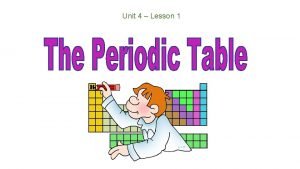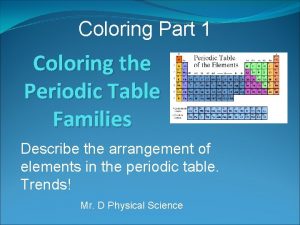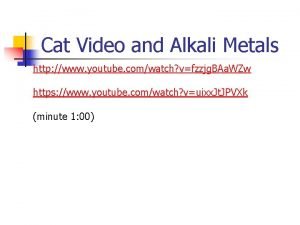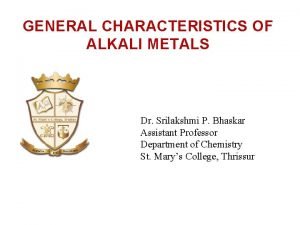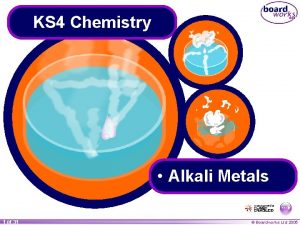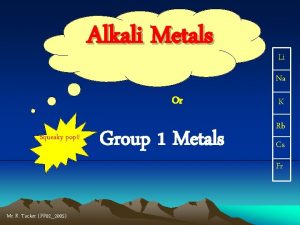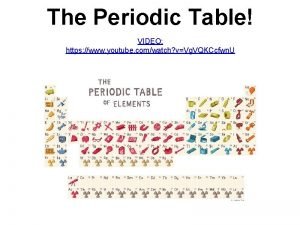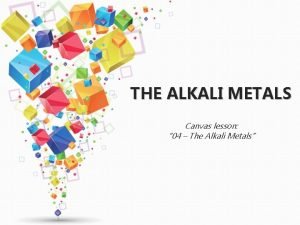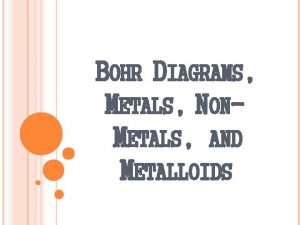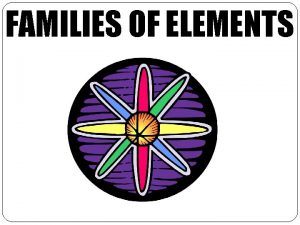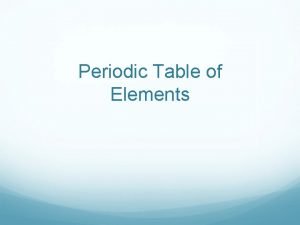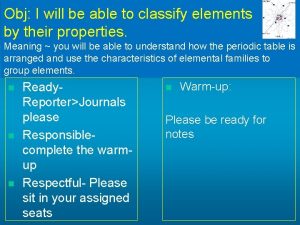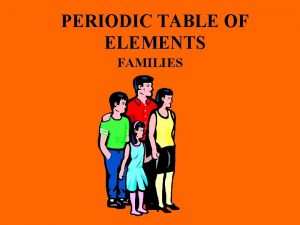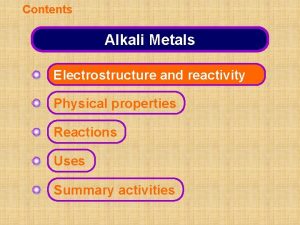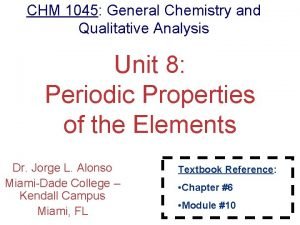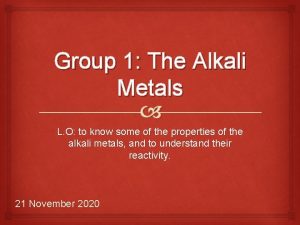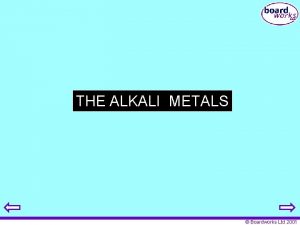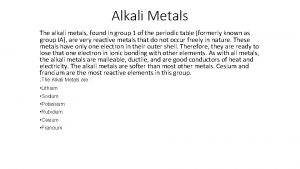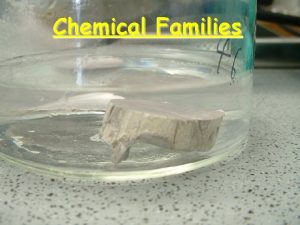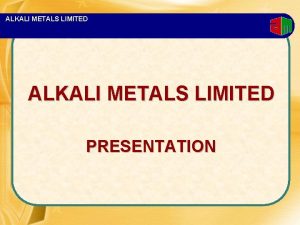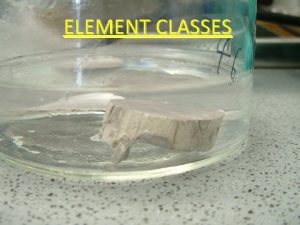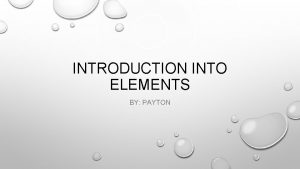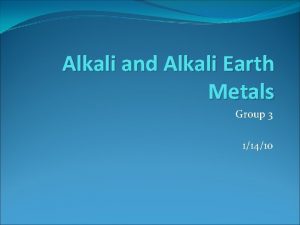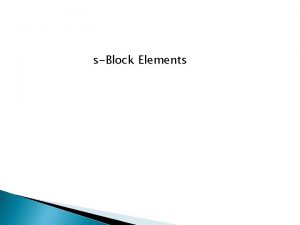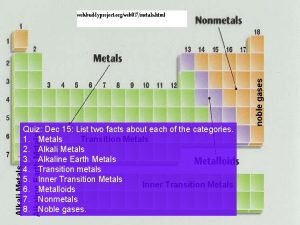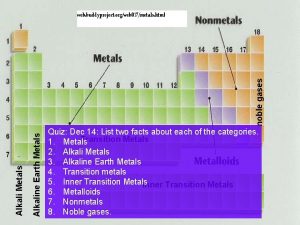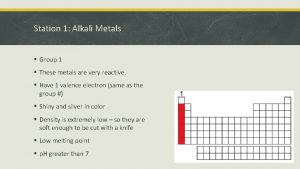Where are the alkali metals The elements in



















- Slides: 19

Where are the alkali metals? The elements in group 1, on the left of the periodic table, are called the alkali metals. lithium Li sodium Na potassium K rubidium Rb caesium Cs francium Fr These metals are all very reactive which makes them different from other metals

THE UNUSUAL PROPERTIES OF THE ALKALIS METALS 1. HOW ARE GROUP 1 METALS STORED? Ø The alkali metals are so reactive that, as elements, they have to be stored in oil. Ø This stops them reacting with oxygen in the air.

2. GROUP 1 METALS ARE ALL SOFT? Ø Alkali metals are soft enough to be cut with a knife. Ø They become softer as we go down the

3. SOME GROUP 1 METALS HAVE LOW DENSITY AND FLOAT ON WATER? Ø Most common alkali metals, lithium, sodium and potassium, all float on water as they have low densities compared to other metals of the Periodic Table. What is the trend in density? The alkali metals generally become more dense going down the group, but the trend is not perfect because potassium is less dense than sodium. Element lithium sodium potassium rubidium caesium Density (g/dm 3) 0. 53 0. 97 0. 86 1. 53 1. 87 Water has a density of 1 g/dm 3. Which elements in group 1 will float on water?

4. GROUP 1 METALS HAVE LOW MELTING AND BOILING POINTS Ø The melting and boiling points of group 1 metals are much lower than other metals What is the trend in melting and boiling points? The melting points and boiling points of alkali metals decrease going down the group. The melting and boiling points decreases as we go down the group.

Electron structure All alkali metals have 1 electron in their outer shell. This means that: lithium 2, 1 l They can easily obtain a full outer shell by losing 1 electron. sodium 2, 8, 1 l They all lose their outer shell electron in reactions to form positive ions with a +1 charge. l They have similar physical potassium and chemical properties. 2, 8, 8, 1

The metal loses electrons from its outer shell to form a positive +1 ion i. e. Na Sodium atom (Na) Sodium ion (Na+)

REACTION OF GROUP 1 METALS WITH WATER All the alkali metals react vigorously with water. It is an exothermic reaction as it releases a lot of heat. The reaction produces hydrogen gas that ignites a lighted splint with a squeaky pop. When green universal indicator is added to the reaction mixture, it turns purple. This shows that the reaction produces a substance which is an alkalis Hence this is why they are know as alkalis metals

Lithium with water VIDEO

How does lithium react with water? Ø From this video we can see that when lithium is added to water: Ø it fizzes Ø It floats Ø it moves around slowly across the surface of the water. Ø It DOES NOT produce a flame NOTE: Lithium is the least reactive of the alkali metals.

The equation for this reaction is shown below: lithium + water lithium hydroxide + hydrogen 2 Li (s) + 2 H 2 O (l) 2 Li. OH (aq) + H 2 (g) REMEMBER/ Alkalis solutions contain OH- ions, hence it is the Lithium hydroxide which turns the indicator blue

Watch the video below to show sodium reacts with water https: //www. youtube. com/watch? v=ODf_s. Pex. S 2 Q Ø From this video we can see that when sodium is added to water: Ø it fizzes Ø It floats Ø it moves across the surface of the water quickly Ø And it burns with a yellow/orange flame

The equation for this reaction is shown below: sodium + water 2 Na (s) + 2 H 2 O (l) sodium hydroxide + hydrogen 2 Na. OH (aq) + H 2 (g) Again it is the Sodium hydroxide which turns the indicator blue

Potassium with water VIDEO

From this video we can see that when potassium is added to water: Ø it fizzes Ø It floats Ø it moves across the surface of the water very quickly Ø And it burns with a lilac flame

The equation for this reaction is shown below: potassium + water potassium hydroxide + hydrogen 2 K (s) + 2 H 2 O (l) + H 2 (g) 2 KOH (aq) Again it is the Potassium hydroxide which turns the indicator blue

EXPLANING THE REACTIVITY OF GROUP 1 Li Na K Rb Cs increaseininreactivity increase in reactivity The reactivity of alkali metals increases down the group. + + + lithium 2, 1 sodium 2, 8, 1 potassium 2, 8, 8, 1 As we go down the group the reactivity increases because: Ø There are more electron shells therefore the radius of the atom is bigger Ø So there will be less attraction between the outer shell electrons and the nucleus as the outer electron will be further away Ø There is increased shielding of inner shells So it is because of this that the outer electron is more easily lost as you go down the group

Electron structure and reactivity increase in reactivity The reactivity of alkali metals increases down the group. What is the reason for this? Li Na K Rb Cs l The size of the element’s atoms, and the number of full electron shells, increases down the group. l This means that, down the group, the electron in the outer shell gets further away from the nucleus and is shielded by more electron shells. l The further away an electron is from the positive attraction of the nucleus, the easier it can be lost in reactions. l This means that reactivity increases with the size of the atom.

FANTASTIC VIDEO ON THE REACTIONS OF ALL ALKALIS METALS INCLUDING RUBIDIUM AND CAESIUM https: //www. youtube. com/watch? v=Hv. VUtpd. K 7 xw
 Insidan region jh
Insidan region jh Alkali metals reacting with water
Alkali metals reacting with water Periodic table color coded
Periodic table color coded Alkali metals periodic table
Alkali metals periodic table Alkali cat
Alkali cat Order of mobility of alkali metal ions
Order of mobility of alkali metal ions Li reaction with oxygen
Li reaction with oxygen What element burns with a squeaky pop
What element burns with a squeaky pop Youtube brainiac alkali metals
Youtube brainiac alkali metals Reactivity of group 1 elements
Reactivity of group 1 elements Alkali metals bohr diagrams
Alkali metals bohr diagrams Families of elements
Families of elements Alkali metals periodic table
Alkali metals periodic table Fun facts about alkali metals
Fun facts about alkali metals Alkali metals periodic table
Alkali metals periodic table Periodic table of elements families
Periodic table of elements families Draw the bohr model of chlorine
Draw the bohr model of chlorine General characteristics of alkali metals
General characteristics of alkali metals Alkali metals reacting with water
Alkali metals reacting with water Group one metals
Group one metals

